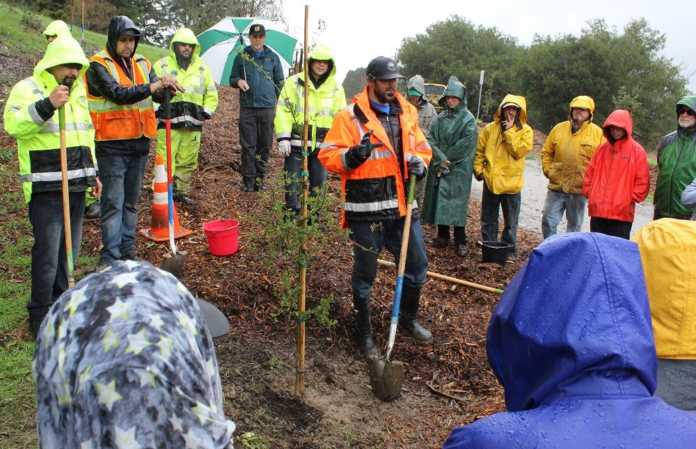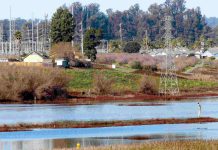WATSONVILLE — The wetlands certainly lived up to its name Saturday morning.
With torrent rains pummeling the region in the early morning, volunteers slipped in the drenching vegetation and shoveled heavy clumps of mud at Ramsay Park as they planted 20 oak trees and smaller plants along Watsonville Slough for World Wetlands Day.
The rain didn’t let up until about a third of the way through the three-hour event, when the clouds cleared just enough to offer the workers a reprieve from the soaking cold.
Still, despite the less-than-ideal conditions, about 50 people showed up to the annual event put on by Watsonville Wetlands Watch and the City of Watsonville.
“It’s completely inspiring that people are coming out in conditions like this,” said Watsonville Wetlands Watch Executive Director Jonathan Pilch. “It’s incredible that people decided to spend their Saturday in this way.”
World Wetlands Day is an annual international celebration of the importance of wetlands and commemorates the signing of the Convention on Wetlands on Feb. 2, 1971 in the Iranian city of Ramsar. The 2019 global theme is “Climate Change and Wetlands.”
Ben Heistein, assistant director of Parks and Community Services, said the volunteers planted a number of different oak varieties, such as coast live oak.
Saturday’s event also put the city more than halfway through its Urban Forest Revitalization Project, a plan approved in late 2017 that calls for 300 trees and hundreds of drought-tolerant native shrubs at 10 park sites and three street corridors. The project is funded by a grant from the California Climate Investment Program and the California Department of Fire and Forestry to Watsonville Wetlands Watch and the City of Watsonville.
The City of Watsonville and Wetlands Watch also received a $1.3 million grant from the California Natural Resource Agency in October that will go toward further habitat improvement efforts along Watsonville Slough. The project was one of 20 others across the state to receive grants.
“The goal of the urban greening project is to plant trees and sequester more of the carbon out of the environment and also improve the walk-ability and bike-ability of the park,” Heistein said. “Trees and trails are the core components of the project.”
Pilch said a number of student field trips are lined up throughout February to continue the work that started Saturday.
New School teacher Bryan Love was joined by one of his students, Yahir Morfin, in the planting efforts.
“We’re stoked to be out here,” Love said. “It’s great fun to be out here in the rain planting trees and being a part of World Wetlands Day.”
Pilch noted an “incredible amount of positive energy” coming from the volunteers.
“It makes the park a more enjoyable place to be,” he said. “Here, somebody gets to do something that will outlive them. They will be planting a tree that will be here for the next several hundred years.”













